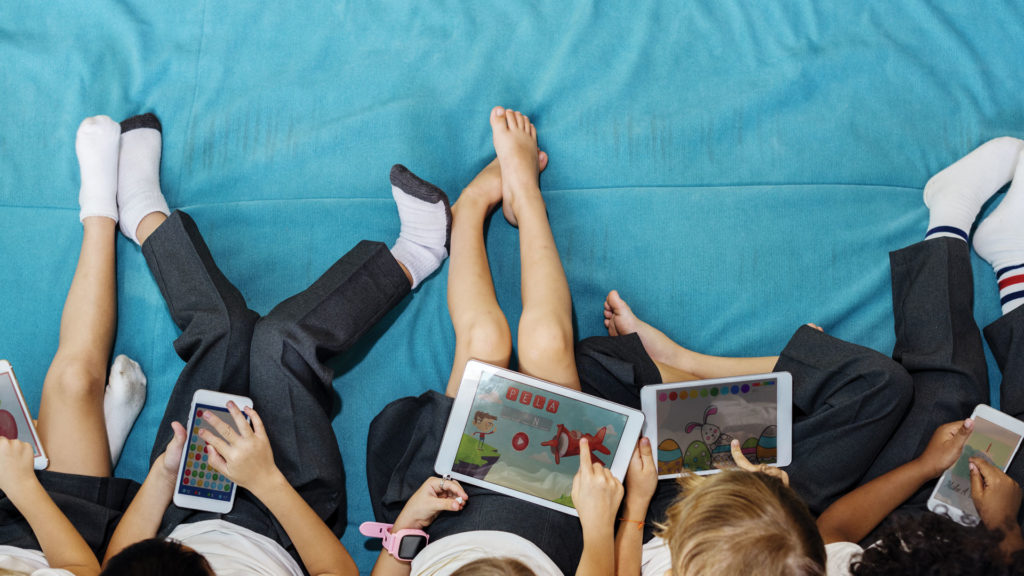The emergence of digital technology has transformed the once-familiar landscape of childhood into something unrecognizable to many parents. Children are drawn to the colorful, animated pictures and enticing sounds of digital devices before many of them have even mastered the art of walking or talking! Children learn through observation, so watching their parents, siblings, and friends spend countless time on their phones and tablets naturally makes them want devices of their own.
While digital devices can, to some extent, serve as learning tools in early childhood development, parents should resist falling into the trap of relying on technology to serve as virtual babysitters for their children. Psychologist Dr. Kari Scovel agrees with the American Academy of Pediatrics’ recommendation that parents of children younger than age five limit screen time to one hour per day.
“The majority of time for kids should be spent in outdoor play, as well as interactive and imaginative play,” Dr. Scovel says, “and co-view with your children when they do have screen time.”
The Early Years
By the time they start elementary school, many children are clamoring for electronic devices. Encouraging your child to put down their phone or tablet is tricky, but there are strategies you can use to help prevent mobile addiction and limit screen time. Be a role model and set a good example by limiting your own use.
“When we’re at our children’s sports events, we should be watching them, not looking at our phones.”
Dr. Kari Scovel, American Academy of Pediatrics
Try setting time limits (some apps have internal timers that will shut off automatically after a predetermined period); establishing rules before use (decide upon a good stopping point, such as after a TV episode or completion of a game level); and having other activities planned for later – maybe reading a book or enjoying a board game.
Popular and affordable options for young children include the Vtech Little Apps Tablet, Fisher Price Laugh & Learn Smart Stages Tablet, LeapFrog My First Learning Tablet, and VATOS Toddler Learning Tablet. Expect to pay $15-$25 for these devices – a price point that won’t cause too much financial hurt if inadvertently left behind in a waiting room or dropped in a bathtub.
Pre-Teens
Once children reach their pre-teens, parents must contend with a whole new set of worries. It is more important than ever to monitor your child’s activities during this time. Pay attention to the websites they are visiting and utilize parental controls and settings to customize content and block inappropriate material.
Now is the time to discuss the threat posed by online predators. Social networking platforms like Facebook and Twitter prohibit users younger than 13, but not all sites are as strict. Utilize online privacy settings, review email and instant messaging history, and place the computer in a common area, such as a living room, to monitor activity.
An excellent option for pre-teens is the Raspberry Pi, a miniature computer about the size of a credit card. It connects to a monitor or TV screen and helps kids learn basic programming. Tablets such as the Kindle Fire are also good choices. Both devices will run between $25-$50. The iPad may be sleeker, but it’s quite a bit more expensive.
Welcome to Teen Life
As children enter their teens, they clamor for freedom. This is when parents typically allow mobile phone use. Be sure to reinforce the notion that you are the parent and are responsible for their safety.
Continue to monitor usage and talk about things like cyberbullying, trolling, and the dangers of clicking on suspicious links or divulging personal information. Make sure all antivirus software is up to date to avoid downloading harmful malware. Dr. Scovel recommends familiarizing yourself with all apps and games your teen has downloaded to ensure they are appropriate, and getting to know their online friends in person.
For teenagers, smartphones, tablets, and video games are popular and age-appropriate devices. Costs vary widely, ranging from $25 to over $500.
Digital Safety Tips
- Educate your children on digital safety and responsibility (including sexting, predators, and cyber-bullying) and why you need to monitor their use.
- Employ time usage reports and automatic shut off tools for your devices.
- Learn how to use Virtual Private Networks to hide your IP address.
- Use apps and content blockers (NetSanity, Tiny Filter, Net Nanny, Qustodio, and many others) to monitor usage and filter out adult content. Apps such as Vast Boost allow you to manage all devices in your household from one screen and turn off wi-fi on kids’ devices.
- Only allow device, computer, and TV usage in a common space, such as a living room, for easier monitoring at home.
- Visit sites such as commonsensemedia.org for information on children’s movies and apps.
WORDS BY MARK PETRUSKA & KRISTINA ROTH

